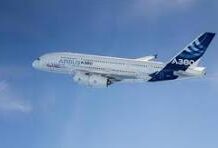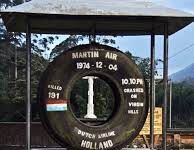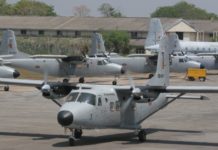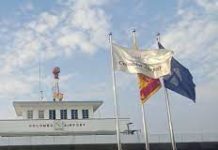Almost 80 years after it unfolded in the sky over San
Diego, a nearly impossible rescue mission remains one of
the most daring feats in aeronautical history.
It began like any other May morning in California. The sky was
blue, the sun hot. A slight breeze riffled the glistening waters of
San Diego Bay. At the naval airbase on North Island, all was
calm.
At 9:45 a.m., Walter Osipoff, a sandy-haired 23-year-old Marine
second lieutenant from Akron, Ohio, boarded a DC-2 transport for
a routine parachute jump. Lt. Bill Lowrey, a 34-year-old Navy test
pilot from New Orleans, was already putting his observation plane
through its paces. And John McCants, a husky 41-year-old
aviation chief machinist’s mate from Jordan, Montana, was
checking out the aircraft that he was scheduled to fly later.
Before the sun was high in the noonday sky, these three men
would be linked forever in one of history’s most spectacular
midair rescues.
Osipoff was a seasoned parachutist, a former collegiate wrestling
and gymnastics star. He had joined the National Guard and then
the Marines in 1938. He had already made more than 20 jumps
by May 15, 1941.
That morning, his DC-2 took off and headed for Kearney Mesa,
where Osipoff would supervise practice jumps by 12 of his men.
Three separate canvas cylinders, containing ammunition and
rifles, were also to be parachuted overboard as part of the
exercise.
Nine of the men had already jumped when Osipoff, standing a
few inches from the plane’s door, started to toss out the last
cargo container. Somehow the automatic-release cord of his
backpack parachute became looped over the cylinder, and his
chute was suddenly ripped open. He tried to grab hold of the
quickly billowing silk, but the next thing he knew he had been
jerked from the plane—sucked out with such force that the
impact of his body ripped a 2.5-foot gash in the DC-2’s aluminum
fuselage.
Instead of flowing free, Osipoff’s open parachute now wrapped
itself around the plane’s tail wheel. The chute’s chest strap and
one leg strap had broken; only the second leg strap was still
holding—and it had slipped down to Osipoff’s ankle. One by one,
24 of the 28 lines between his precariously attached harness and
the parachute snapped. He was now hanging some 12 feet below
and 15 feet behind the tail of the plane. Four parachute shroud
lines twisted around his left leg were all that kept him from being
pitched to the earth.
Dangling there upside down, Osipoff had enough presence of
mind to not try to release his emergency parachute. With the
plane pulling him one way and the emergency chute pulling him
another, he realized that he would be torn in half. Conscious all
the while, he knew that he was hanging by one leg, spinning and
bouncing—and he was aware that his ribs hurt. He did not know
then that two ribs and three vertebrae had been fractured.
Inside the plane, the DC-2 crew struggled to pull Osipoff to
safety, but they could not reach him. The aircraft was starting to
run low on fuel, but an emergency landing with Osipoff dragging
behind would certainly smash him to death. And pilot Harold
Johnson had no radio contact with the ground.
To attract attention below, Johnson eased the transport down to
300 feet and started circling North Island. A few people at the
base noticed the plane coming by every few minutes, but they
assumed that it was towing some sort of target.
Meanwhile, Bill Lowrey had landed his plane and was walking
toward his office when he glanced upward. He and John McCants,
who was working nearby, saw at the same time the figure
dangling from the plane. As the DC-2 circled once again, Lowrey
yelled to McCants, “There’s a man hanging on that line. Do you
suppose we can get him?” McCants answered grimly, “We can
try.”
Lowrey shouted to his mechanics to get his plane ready for
takeoff. It was an SOC-1, a two-seat, open-cockpit observation
plane, less than 27 feet long. Recalled Lowrey afterward, “I didn’t
even know how much fuel it had.” Turning to McCants, he said,
“Let’s go!”
Lowrey and McCants had never flown together before, but the
two men seemed to take it for granted that they were going to
attempt the impossible. “There was only one decision to be
made,” Lowrey later said quietly, “and that was to go get him.
How, we didn’t know. We had no time to plan.”
Nor was there time to get through to their commanding officer
and request permission for the flight. Lowrey simply told the
tower, “Give me a green light. I’m taking off.” At the last
moment, a Marine ran out to the plane with a hunting knife—for
cutting Osipoff loose—and dumped it in McCants’s lap.
As the SOC-1 roared aloft, all activity around San Diego seemed
to stop. Civilians crowded rooftops, children stopped playing at
recess, and the men of North Island strained their eyes upward.
With murmured prayers and pounding hearts, the watchers
agonized through every move in the impossible mission.
Within minutes, Lowrey and McCants were under the transport,
flying at 300 feet. They made five approaches, but the air proved
too bumpy to try for a rescue. Since radio communication
between the two planes was impossible, Lowrey hand-signaled
Johnson to head out over the Pacific, where the air would be
smoother, and they climbed to 3,000 feet. Johnson held his plane
on a straight course and reduced speed to that of the smaller
plane—100 miles an hour.
Lowrey flew back and away from Osipoff, but level with him.
McCants, who was in the open seat in back of Lowrey, saw that
Osipoff was hanging by one foot and that blood was dripping from
his helmet. Lowrey edged the plane closer with such precision
that his maneuvers jibed with the swings of Osipoff’s inert body.
His timing had to be exact so that Osipoff did not smash into the
SOC-1’s propeller.
Finally, Lowrey slipped his upper left wing under Osipoff’s shroud
lines, and McCants, standing upright in the rear cockpit—with the
plane still going 100 miles an hour 3,000 feet above the sea—
lunged for Osipoff. He grabbed him at the waist, and Osipoff flung
his arms around McCants’s shoulders in a death grip.
McCants pulled Osipoff into the plane, but since it was only a twoseater, the next problem was where to put him. As Lowrey eased
the SOC-1 forward to get some slack in the chute lines, McCants
managed to stretch Osipoff’s body across the top of the fuselage,
with Osipoff’s head in his lap.
Because McCants was using both hands to hold Osipoff in a vise,
there was no way for him to cut the cords that still attached
Osipoff to the DC-2. Lowrey then nosed his plane inch by inch
closer to the transport and, with incredible precision, used his
propeller to cut the shroud lines. After hanging for 33 minutes
between life and death, Osipoff was finally free.
Lowrey had flown so close to the transport that he’d nicked a 12-
inch gash in its tail. But now the parachute, abruptly detached
along with the shroud lines, drifted downward and wrapped itself
around Lowrey’s rudder. That meant that Lowrey had to fly the
SOC-1 without being able to control it properly and with most of
Osipoff’s body still on the outside. Yet, five minutes later, Lowrey
somehow managed to touch down at North Island, and the little
plane rolled to a stop. Osipoff finally lost consciousness—but not
before he heard sailors applauding the landing.
Later on, after lunch, Lowrey and McCants went back to their
usual duties. Three weeks later, both men were flown to
Washington, DC, where Secretary of the Navy Frank Knox
awarded them the Distinguished Flying Cross for executing “one
of the most brilliant and daring rescues in naval history.”
Osipoff spent the next six months in the hospital. The following
January, completely recovered and newly promoted to first
lieutenant, he went back to parachute jumping. The morning he
was to make his first jump after the accident, he was cool and
laconic, as usual. His friends, though, were nervous. One after
another, they went up to reassure him. Each volunteered to jump
first so he could follow.
Osipoff grinned and shook his head. “The hell with that!” he said
as he fastened his parachute. “I know damn well I’m going to
make it.” And he did.
This article first appeared in the May 1975 edition of Reader’s Digest.












